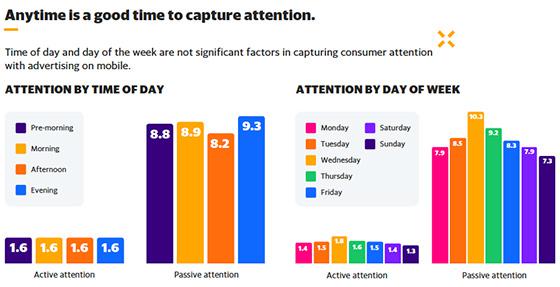by Laurie Sullivan @lauriesullivan
Source: www.mediapost.com, August 2022
Omnicom Media Group (OMG), Yahoo and Amplified Intelligence released a study Thursday that focuses on identifying when consumers pay attention to ads — and when they don’t.
Findings from the research conducted across Yahoo’s digital properties showed that 53% of all ad formats studied met viewability standards, but achieved less than 1 second of active attention.
The study shows that viewability and attention are not the same. The research shows how viewability is device-driven — determined by how and where the ad gets loaded on the screen — while attention is human-driven by how the viewer responds to the ad served on the screen.
Caitriona Henry, global brand strategy lead at OMD Worldwide, believes it’s important to optimize marketing strategies to earn higher levels of consumer attention. It’s something OMD and Amplified Intelligence have been working on for the past two years to establish attention key performance indicators (KPIs).
All respondents for the study were recruited, and volunteered. Amplified Intelligence’s technology collected the data using facial footage from phone cameras and metadata on viewability, scroll patterns, sound and phone orientation.
Altogether, responses to 128,000 mobile web advertisements were categorized into three levels of attention such as active, eyes on the ad; passive, eyes on screen, not on ad; and non-eyes, eyes not on screen or ad.
Research was conducted in the U.S., Canada, the United Kingdom, and Australia.
Elizabeth Herbst-Brady, head of global revenue and client solutions at Yahoo, believes the findings from the study reveal the nuances of consumer attention. It requires combining the right formats in the right environment and context relevant to each audience.The research shows how behavior evolves to enable more engaging experiences.
Whether or not a consumer pays attention impacts a brand’s growth. By paying attention to a message, the person retains the message, and the marketer can use the data to grow the brand. If the person doesn’t pay attention, the opposite occurs.
The human is the “ultimate variable,” because it’s impossible to know what is ignored and what gets the focus. A person only has so much attention to give. There is only so much information a person can take in through their eyes.
The data shows that there are four types of content and ad formats that keep eyes on ads and screens in a mobile web environment. These include immersive, high-impact, short, and big.
Marketers should try to gain at least 2.5 seconds of active attention. Interscroller ads were found to keep the attention of participants for about 3.3 seconds, video interscrollers about 3 seconds, and native video ads about 2.8 seconds.
The 15-second video ads delivered 2.8x more active attention than 30-second videos. The study also found that the larger the ad size, the more active attention the ad received.
Many factors drive attention, and no single factor is responsible for the best result. The active attention given to the ad is influenced by the ad format as well as the category.
Age is also important. Gender did not determine the amount of attention given to ads, but the older your audience, the more attention they give. The age group 55 and up gave 12 seconds of passive attention and 2.1 seconds of active attention. The 45-54 age group gave 11.2 seconds of passive attention and 1.9 seconds of active attention. These results can be compared with the 18-24 age group, which had 7.6 seconds of passive attention and 1.3 seconds of active attention.
Amplified Intelligence founder and CEO Karen Nelson-Field believes the work adds to the growing body of evidence showing that getting the attention of consumers is neither a commodity nor a currency. She referred to it as a “highly nuanced metric that enables more effective creative, planning and buying strategies, and decisions.”


Interesting findings, Laurie. What’s particularly important for advertisers to note is that a 15-second commercial on mobile—per this study— generates only about 3-3.5 seconds of eyes-on-screen viewing by the audience which means that only 20% or so of the message is “watched”. In contrast, TVision’s “eye cameras” report roughly twice as much visually attentive time spent viewing ad messages of the same length for linear TV commercials. Clearly, this has a bearing on ad impact. Just as clearly, it suggests that mobile commercials need to be developed differently—to capture attention as quickly as possible—which may be a difficult proposition for many campaigns to deal with—especially those reying on moods, humor, product demonstration, etc.